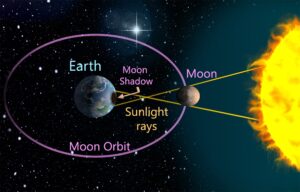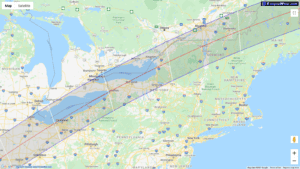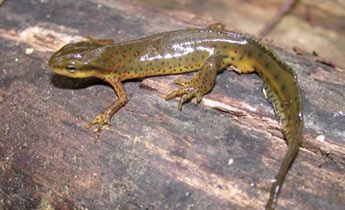This article was originally printed through Life in the Finger Lakes November December 2023 issue. We are proud to have been featured in this magazine and welcome you to read it below.
Here’s what you need to know for the Total Solar Eclipse – April 8, 2024
The concept of an eclipse is not new to me, but if I had to answer questions about it to participate in a local trivia night, I would probably very quickly hang my head in shame at my complete lack of knowledge regarding this amazing phenomenon. My only childhood recollection of an eclipse was when we had to pull down the shades in class one afternoon in elementary school, with everyone trying to sneak a peek but told to not look directly at it for fear of being blinded forever and ever. To be fair, the concern of being blinded resonated quite a lot in my 8-year-old brain so all other information was inconsequential in comparison. In August 2017, my neighbor and I crossed paths during our afternoon dog walking and he was incredibly excited about the upcoming eclipse a few days away. As a retired physicist, umbraphile (an eclipse chaser and enthusiast) his excitement was palpable as he shared scientific details that were way beyond my understanding. I made a mental note to experience the upcoming eclipse with my two small children. The big day came and it looked like any other day. News reports shared information about not looking directly at the sun (isn’t that always a recommendation?) and that you would need special eclipse glasses (sold out everywhere!) to be able to experience the magic. Out we went at the right time, standing on our porch. Ok… now what? I remember hearing there would be many parts of the country that would be in totality, meaning they would have complete darkness for several minutes as the moon covered the sun. Not being in the path of totality, it looked like a regular sunny day to me. Hmm… maybe I would have to put on my calendar the next eclipse he talked about as we would be in the path of totality. So now, here we are 6 years later, with the path of totality eclipse on our calendars for April 8, 2024. I’m understanding this to be a really big deal in the science world (and in our nation as a whole) but I must admit that the details of this are over my head. So I write this as a guide for the rest of us: those who don’t have a degree in science and remember only a brief (excuse the pun) blip in the matrix as the moon passed the sun. Let’s start with the basics and you’ll be yelling out those trivia night questions with confidence before you know it! What is an eclipse? An eclipse occurs when one celestial body (Earth, Moon and Sun) passes through the shadow of another celestial body, resulting in a temporary reduction of light. The most common types of eclipses are solar and lunar.
- Solar Eclipse: This occurs when the Moon passes between the Earth and the Sun, casting a shadow on the Earth’s surface. There are two main types of solar eclipses: total and partial.
- Total solar eclipse: The Moon completely covers the Sun and creates a temporary darkening of the sky during the daytime. Our 2024 event is a perfect line-up where the moon and sun will appear the same size and a total cover will take place. These are rarer than their partial eclipse counterparts, occurring roughly every 18 months somewhere on Earth and only once every 385 years in any single location. This is what we will experience on April 8, 2024.
- Partial solar eclipse: Only a portion of the Sun is covered by the Moon, which leaves a smaller crescent-shaped Sun. The next partial eclipse is on Saturday, October 14, 2023.

- Lunar Eclipse: This happens when the Earth comes between the Sun and the Moon, causing the Earth’s shadow to fall on the Moon. There are two main types of lunar eclipses: total and partial.
- Total lunar eclipse: The Earth’s shadow completely covers the Moon, giving it a reddish hue due to the scattering of sunlight through the Earth’s atmosphere. This is often called a “blood moon.”
- Partial lunar eclipse: Only a part of the Moon enters the Earth’s shadow, causing a portion of the lunar surface to darken.
Isn’t a new moon and a lunar eclipse the same thing? The short answer is no. New moons occur because of our changing viewpoint of the Moon; lunar eclipses occur when the Earth gets in the way of the light from the Sun and stops it hitting the Moon. New moons occur when the Moon is between the Sun and the Earth; lunar eclipses occur when the Earth is between the Sun and the Moon. What can we expect during a total solar eclipse?
- Darkening of the sky
- Visibility of stars and planets normally unseen
- A pearly-white halo that surrounds the blocked Sun called the corona appearance
- Points of sunlight that peek through the rugged lunar landscape along the edge of the Moon, creating a string of shimmering beads called Baily’s Beads
- As totality approaches its end, a bright spot of sunlight called the “diamond ring” effect becomes visible.
- Temperature drop of up to 10 degrees
- 300,000-500,000 extra visitors in our Finger Lakes Region chasing the eclipse
Eclipse dos and don’ts: 
- Do go outside to experience this.
- Do turn off automatic lights so that they won’t disturb the effect.
- Do use sites like TheGreatAmericanEclipse.com and TimeAndDate.com and RochesterEclipse2024.org to learn more about how the eclipse will affect your specific area and what events are going on to celebrate!
- Don’t look at the sun without eclipse-specific eye protection (1000 times stronger at blocking harmful radiation than regular sunglasses) EXCEPT for during totality.
- Don’t use sunglasses as a substitute for eclipse glasses, no matter how dark they are.
- Don’t worry if it’s cloudy – it will still become dark!
- Don’t be like Marge Simpson in episode 433 of the TV series The Simpsons. She looks directly into the sun during a solar eclipse series and damages her eyes!
Where can I see this eclipse? The path of totality will stretch from Mexico to Canada, passing through Texas, Oklahoma, Arkansas, Missouri, Illinois, Indiana, Ohio, New York, Vermont, and parts of Quebec in Canada.  Yes, our beloved Rochester, New York, is indeed in the path of totality for the total solar eclipse. The fun begins at 2:07pm, with totality beginning at 3:20pm, lasting 3 minutes and 38 seconds, and will end at 4:33pm.This eclipse will pass through the entire state of NY in a matter of only 10 minutes with a 100-mile wide path and a speed of 2,344 mph. Where can I find more information? As part of the outreach for this path of totality, which won’t happen again in the Rochester region until 2144, the Strasenburgh Planetarium at the Rochester Museum and Science Center (RMSC) has designated eclipse ambassadors to share the news and excitement, with events to celebrate. The Saunders Finger Lakes Museum is in good company with the Yates County Chamber of Commerce as eclipse partner along with 50+ other organizations in the area. Details are forthcoming for these events as the date approaches! As an eclipse embassador, the Saunders Finger Lakes Museum is excited to provide programming and events in the upcoming weeks. Details are being finalized and will be shared on our Programs page. Stay tuned for more details!
Yes, our beloved Rochester, New York, is indeed in the path of totality for the total solar eclipse. The fun begins at 2:07pm, with totality beginning at 3:20pm, lasting 3 minutes and 38 seconds, and will end at 4:33pm.This eclipse will pass through the entire state of NY in a matter of only 10 minutes with a 100-mile wide path and a speed of 2,344 mph. Where can I find more information? As part of the outreach for this path of totality, which won’t happen again in the Rochester region until 2144, the Strasenburgh Planetarium at the Rochester Museum and Science Center (RMSC) has designated eclipse ambassadors to share the news and excitement, with events to celebrate. The Saunders Finger Lakes Museum is in good company with the Yates County Chamber of Commerce as eclipse partner along with 50+ other organizations in the area. Details are forthcoming for these events as the date approaches! As an eclipse embassador, the Saunders Finger Lakes Museum is excited to provide programming and events in the upcoming weeks. Details are being finalized and will be shared on our Programs page. Stay tuned for more details!



